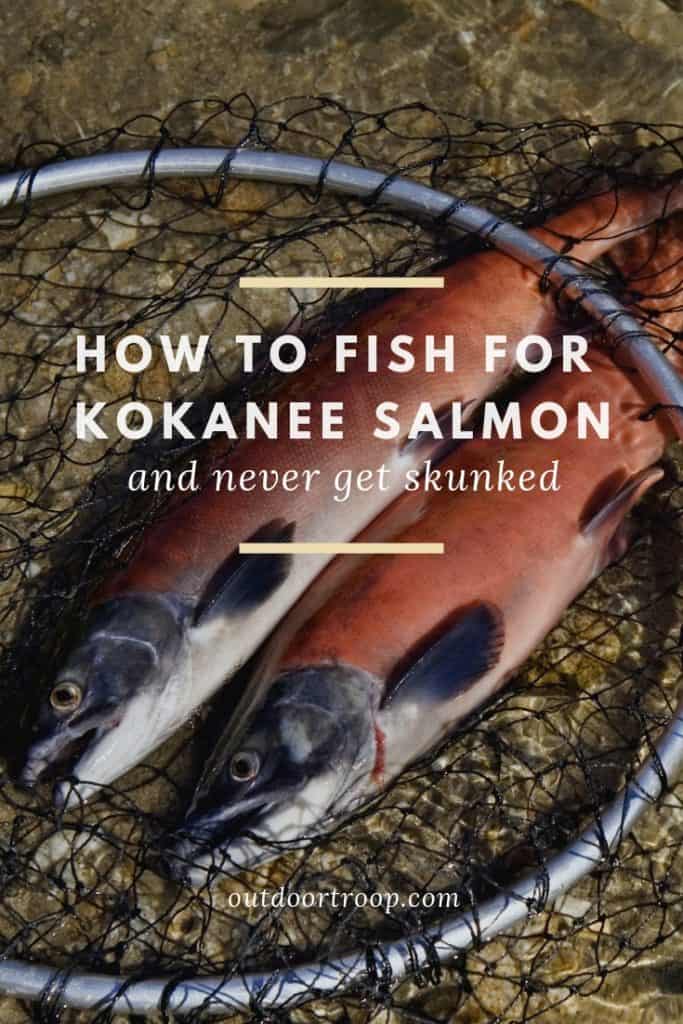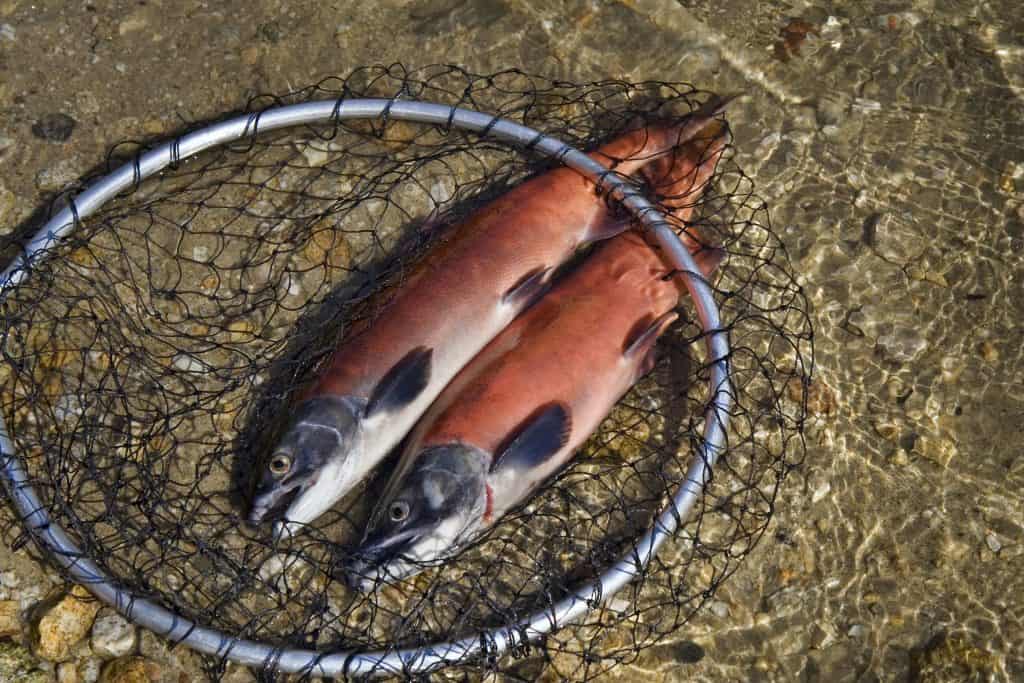
Kokanee Salmon are actually Sockeye Salmon that do not migrate back to the ocean. Most of the time, Kokanee are landlocked in lakes or small offshoots of rivers. Some live in rivers that head back to the ocean, but they do not have the instinct to go to the ocean.
So, how is Kokanee fishing done? The main method of catching Kokanee Salmon is trolling around a few lines that have dodgers followed by spinner lures or spoons. A difference between Kokanee fishing and other fishing is the lures and baits used aren’t usually meant to attract the fish. They’re meant to irritate until the fish bite.
Kokanee are very aggressive fish and, as long as it is not scaring them, the Kokanee are more likely to strike out at an annoying fish or debris floating in the water. There are a few things that the Kokanee Salmon hate the most, and those things are pinks, zigzag-ing lures, and stinky bait.
Kokanee Salmon: What You Need to Know
Kokanee Salmon came from the ocean around 15,000 years ago when there were more lakes and rivers over the America. As the rivers retreated and the lakes separated from some streams, there were sockeye salmon that were not able to get back to the ocean.
They adapted to their new environment over time, and soon, there was no urge or need to head back to the ocean to spawn. The Kokanee Salmon changed from their original species so much that even today Kokanee Salmon cannot reproduce with Sockeye Salmon.
Kokanee salmon don’t hang out close to lakeshores, so using a boat is sometimes necessary.
Kokanee salmon, like other types of salmon, mature around the age of 3 to 5 years of age. During this time they do not attempt to get to the ocean. Most of the species does not have a way back to the ocean, but the species as a whole has changed to not have that drive.
After finding a lake with Kokanee in them, you will want to buy some gear.
Trolling is a great method for catching Kokanee Salmon in larger lakes, and you can have some luck in the smaller streams. Smaller streams are usually fished from the bank, however.
But on to the actual methods now. Find yourself a lake and get your boat out there. Its time for some trolling!
Trolling
Trolling is not sending mean comments to someone over the Internet. Trolling is pulling a hook and other accessories behind your boat as you travel around the lake. They’re still connected to a rod and reel, but those are securely connected to the boat.
With trolling, there are a few things that will change your success levels.
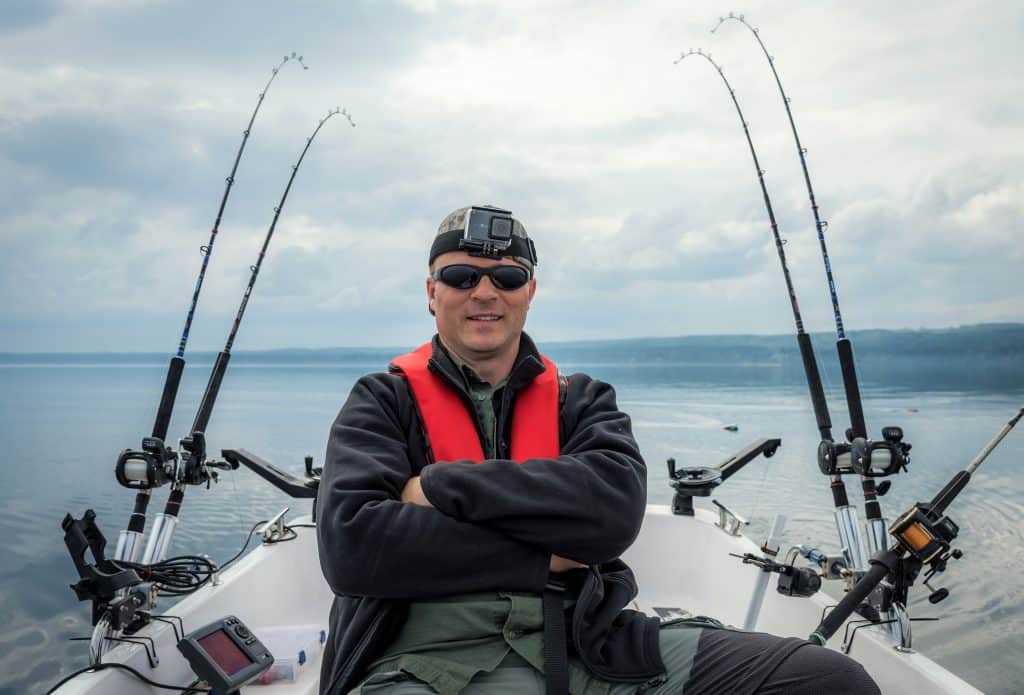
Baits
Kokanee bite because of smells. Its pretty simple. If it smells irritating, which can mean a few different things, then the Kokanee will bite out at it, trying to kill it and get it away from themselves.
The best baits that work well are corn, maggots, shrimp, and salmon eggs. If they are pink, then the Kokanee will be more likely to bite it. The corn is used not because it smells bad, but because it can keep in substances that smell strongly very well.
The best bait that I have used in kokanee trolling is some full kernel corn that I let sit out over 36 hours with some garlic.
The garlic will be a different smell that most Kokanee won’t have smelt before. This new smell will irritate them, especially because of how strong the smell will be.
Most fishermen have some secret recipe for stink baits, but not everyone is willing to share their secrets. Companies have started selling concoctions that smell absolutely horrible, but the other fish do not seem to be mad at the smell. Only the Kokanee are irritated.
Pro-Cure’s Kokanee Sauce is one of the best stink baits out there. It is very smelly, so the fish will be more attracted to it because of that. The bait is also very sticky, so it will stay put longer and give off its smell for a long time as well.
Maggots smell horrific as well, but since the ones you should buy are going to be dyed pink, they will look horrific to the Kokanee, too. The same with shrimp as well.
Put a kernel on a hoochie lure and drop it down into the water and the fish will come looking to bite.
Lures
There are a number of lures that work well when trolling for Kokanee. Most types of spinners work well. Spoon lures can attract more fish over to where you are boat goes, so be sure to cross over places that you have been before to try to catch those late fish.
Wedding Ring Lures, bugs, and some crankbaits work well. What I have found that works for me is using a pink or sliver hoochie and attaching a piece of corn or a small maggot to one of the hooks on the hoochie. Running that behind a boat will work fairly well.
Squid baits are also frequently used. The plastic limbs that trail from the body tend to annoy the Kokanee Salmon, which makes them strike out. Do not be shy to add corn, maggots, or shrimp to a lure. If it is small enough, then there won’t be a problem with it affecting the action of a lure.
Other Accessories
A trolling set up would not be complete without dodgers trailing between the boat and the lures. Dodgers are basically spoon lures without the hook at the other end. Dodgers are attached to the line from both sides, acting as a swivel between leader and line.
The action of the dodger acts as a fish that is swimming in a school when paired with multiple dodgers. The shape of the dodger also creates water disruption. Fish will notice this and follow the lures around.
Make sure that any lure without action is at least 2.0X the length of the dodger. A lure with its own action should not be that close, so instead, the lure should be around 3 to 4 times the This will allow the lure to perform its own action and not be affected by the dodger as it moves.
Getting the lures and dodgers down to the wanted depth can be hard without an expensive downrigger. The downrigger is not a necessary accessory. But, there is an easy alternative.
Using a three-way swivel, you can attach a lure to the line on the third part. You should refrain from putting on too many weights because when you fight the fish, you’re going to be trying to bring in all of those weights too. It’s you against yourself and the fish.
Because the Kokanee Salmon have very soft and sensitive mouths, it is sometimes wise to put a rubber bungee around it. However, it is very visible to the fish. The bungee will keep the set light and not yank the hook from the fish’s mouth.
Speed
You don’t want to go too fast in your boat for a few reasons. The first is that typically, the faster you go, the louder your engine will be. This can scare away the fish, which is a bad thing.
The second reason is that any fish that is not spooked by the boat will not be able to bite at the lure if you’re passing them at 20 MPH. The fish are fast, but they aren’t ‘bait-flashed in-their-faces-for-only-1-millisecond’ fast.
A good speed is a slow 0.8 mph to 1.4 mph. try different speeds in this range as you go around the lake. When controlling where the boat goes, be sure to make a lot of turns. This is where you will catch the most fish.
The turns work well because one side of the boat’s lures will drop and travel a tiny bit slower, which is what baitfish do when slowing to eat something.
The side that is raised will speed up as it comes up, which acts like a baitfish getting away from a predator or trying to eat something pretty close. The Kokanee Salmon will react to this and naturally strikeout. If you’re lucky, you’ll hook one and be able to bring it in.
Location on the lake
A fishery is a place where the intent is to get fish in a lake and will continue to support the fish for a while. The main goal of a fishery is to increase the population of a species to attempt getting a commercial fishery able to sell fish for a revenue. This takes a pretty big toll on a species, so the attempt on creating a fishery is no small task.
Kokanee Salmon usually swim around 50 to 60 feet of the shore. They tend to swim parallel with the shore, so follow the shore around in an S-pattern. The dipping of the lures as you turn a little will make the dodgers and hooks look more like realistic baitfish.
The Kokanee usually swim around 45 and 60 feet, but they are also commonly found swimming around 65-80 feet as well. Start around 30 feet depth and then work your way down until you catch fish. Once that stops working, go deeper. Once you get too deep, however, reel back up or call it a day.
Make sure not to get too close to shallower areas of the lake. This can cause you to lose a hook or to lose your whole setup. The fish aren’t in shallower areas, so it’s useless fishing in those areas.
Times
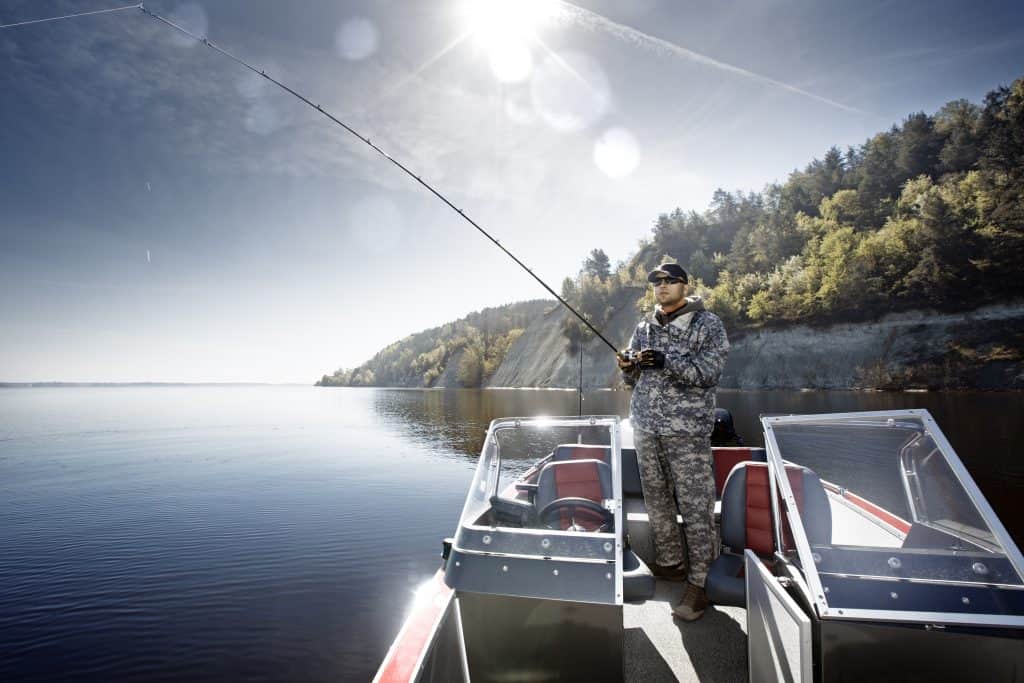
The moon phases actually can make the level of success change depending on what they are. The full moon phases are better for catching fish during the afternoon hours.
During a new moon, or around the time that a new moon is going to happen, first light is better than later in the day. This means getting up early in the morning and beating the sun onto the water to troll.
Once you get to a depth of about 65 feet down, the moon phase doesn’t totally matter. It’s the shallower depths, around 45 to 60 feet that it matters the most. Very rarely are there fish above 30 feet, so drop a line down deep.
Once you get to a depth of about 65 feet down, the moon phase doesn’t matter.
The best times to catch Kokanee salmon depend on the season more than anything. While Kokanee salmon can be caught during the wither via ice fishing, the best times to catch Kokanee salmon are in between spring and fall.
These warmer months mean that the fish will be closer to the middle of the lake, where there is a good temperature, but the light is still dim enough not to irritate them. Kokanee Salmon tend to bite more during the later part of spring.
Late spring and early summer are when the fish will be at their biggest, just before they start to spawn around. The average spawn date in early September but only lasts for 10 days, After that, the fish will die and there will be smaller fish as summer continues and fall starts.
Jigging for Kokanee
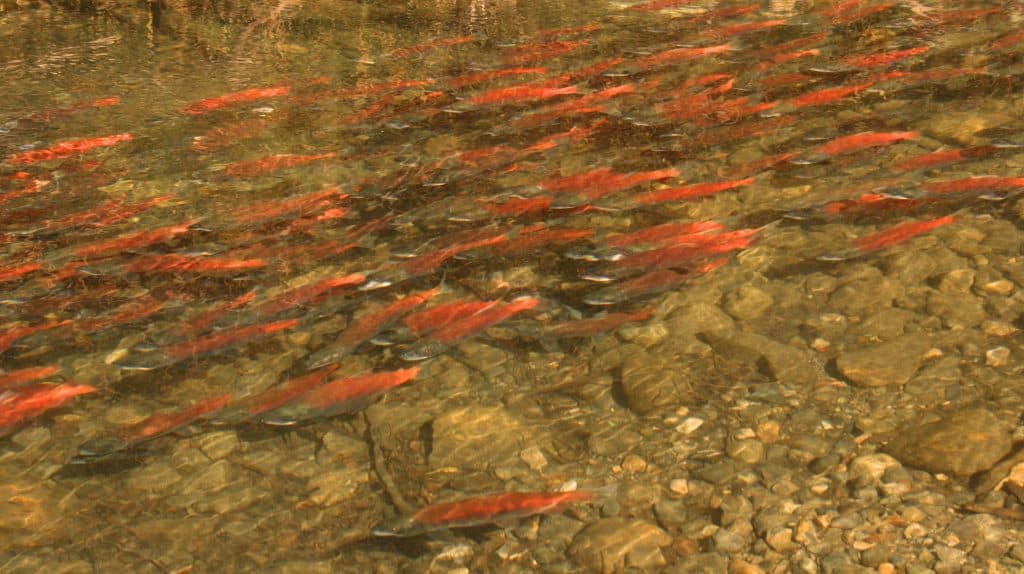
The main method that people speak of fishing for Kokanee is trolling. While this is an effective method, it is not the best method to use year round. Trolling is best done in late summer and fall, where the fish will be more likely to swim after a dodger and hook.
During the early spring and midsummer times, when the water is colder, jigging is the way to go. Kokanee
Locating the fish
The easiest way to find a school of fish that is deep in the water is with an electronic fish finder. These can get expensive, but they are worth every cent. Using sonar, the schools are located as you pass over them. The fish finder will also tell you exactly how deep the school is.
If you don’t have a fish finder, fish in areas that drop deeper down than other places. Most Kokanee, usually stay between 30 and 60 feet of water.
Kokanee Salmon usually swim around 20 to 40 feet from the shore, and they almost always swim parallel with the shore. Keep that in mind when trying to catch Kokanee Salmon.
Equipment
Kokanee jigging equipment is pretty similar to other types of jigging equipment, so for this method, you shouldn’t have to buy too much if you already have the basic fishing equipment.
#1. Rod
The rod that you use should be an ultralight jigging rod. They are commonly sold at around 5 feet to 6 feet. This is a good size for jigging Kokanee.
The light rods will be able to tell when the jig is
#2. Reel
Any reel can work for jigging, but baitcasters seem to be the popular choice with other fishermen. I personally use a spinning reel and have had great success jigging with that.
Depending on how deep the body of water is, make sure that your reel holds at least 3 times the deepest part of that lake. It’s never a good thing to have the reel max out when fishing a good large fish.
#3. Line
In my experience jigging for Kokanee on some of the lakes in Southern Idaho, I’ve never had problems with line breaking. And because of that, I recommend 8-pound braided line behind a 3-6 foot leader of fluorocarbon line. The braid can have some issues with too aggressive sets, but if you have an ultralight rod, then it should be okay.
#4. Jigs
Jigging is the name given to the action of jigging and is also the name given to the hook used in some types of jigging. You can jig with a jig, but you don’t always jig with a jig…
Confusing, right?
A jig as an object is a hook with a lead ball on the line side of the hook. There is a little eyelet that the line goes through. Because it is off to the side and not directly above the hook, it gives the hook and baits what we call ‘action.’ This just refers to how it moves.

Jigging as an action refers to the movement you put on the rod. By jerking the rod and look up and down, the hook moves in a way that is appealing to the fish. Sometimes this means that they will be more likely to bite.
The hooks should be baited with a piece of corn, one per hook. Even if you’re using a spoon or a spinner hook, the corn is small enough that it will only a
#5. Lures
Spinning lures are good for casting and jigging back to you. Sort of like a slower cast and retrieve. Try reeling in at different speeds, but make sure that there is a period of time where the lure is allowed to fall slightly in the water. This will stop the action, but it’s okay.
The action of the lure is meant only to attract a fish over to the bait. When the hook with the corn falls in the water, that’s when the Kokanee Salmon will bite.
Spoons are better for true vertical fishing. The action that the spoon has when it falls in the water makes it seem like a fish tried to swim up. but instead drifts further down into the depths of the water. Drop the spoon down to around a foot or so off of the bottom of the lake, then slightly jerk up on the line at varying intensities and lengths to get the fish to come.
The lure needs to be shiny, so consider using a silver one, or a nickel one. The metal reflecting the sunlight off of it as it falls will irritate the fish. And you know what irritated Kokanee means. Bites.
#6. Fish Finder
The fish finder spoken of in trolling can also be used her. After a school of fish is found, position your boat right over the school. Once you’re in position, you will be able to drop your lure down directly into the school of fish.
Method
There is a certain method to jigging for Kokanee salmon. Kokanee salmon usually bite when the jig is falling down in the water. This means that we want as much emphasis on the fall as we can get. There are a few ways to get this to happen.
Using a spoon, make sure that you use a silver or nickel one. These are usually the correct color, but also because they are a little more compact than other materials.
As a silver spool falls down in the water, it will move side to side as it falls. This action will attract the fish towards the lure and will get more fish to come near where you are fishing.
Most days, there will be a certain rhythm that the fish will hit more than anything else. Try out different pause lengths and/or different jerking speeds. As I feel I often say, these fish are all about the aesthetics. If the action isn’t exactly right, the fish will most likely not bite it.
Be careful when setting the hook. It is important to get the hook set really secure, but because Kokanee have softer mouths, the line between a soft set and a set that’s too hard is as thin as a 4-pound line. It’s very thin.
Other Tips to Catch Kokanee Salmon
- Use multiple lines at varying depths. This helps with getting hooks to more fish.
- Set lines at different distances from the boat. This will get a fish to see more hooks as it travels vertically in the water.
- Dye all of your bait pink.
- Put some scent on your lure to make it more appealing.
- Keep the size of the dodger relatively small. Kokanee
are hunted by some invasive piscivorous fish that are larger than Kokanee.
Kokanee are beautiful fish that taste even better than they look. While they give off a good fight, they are still relatively easy to catch. The main method of catching these landlocked salmon is trolling, which is done by attaching a dodger and a spoon lure to the end of a line and letting the line trail behind the boat as the angler drives the boat at around 0.8 to 1.4 MPH. Anything faster will be too fast for the Kokanee to catch.
For finding the location of the Kokanee Salmon, go where the fish can get the most reward for the least amount of effort. These locations will be at the edges of strong currents where the fish will be able to strike out at passing food and be able to return to the calmer waters to just the edge of the currents.
Like most fish, they have a very specific aesthetic. Kokanee Salmon bite pink baits and lures, but will also bite at reds, oranges, and some light purples. Spoons are great lures, but spinner lures work as well.
When trolling, use a dodger to attract more fish towards your hooks. Put a 1/16 oz spoon lure behind the dodger to imitate a school of fish. But test out new methods. These are the tried and known methods that work well for many fishermen, but not every situation can be covered by these methods. Test things until you get a way that works for you.
Related Questions
How fast do Kokanee salmon grow? Kokanee salmon grow pretty slowly when compared to the Sockeye Salmon in the ocean. Because lakes have a lower nutrients level than the ocean, they will usually grow to be around 12 to 14 inches in two years. Most Kokanee Salmon live to be around 3 years before spawning.
Do Kokanee salmon die after spawning? Once Kokanee, or Sockeye salmon, spawn, they will die around a day to a week later. The fish won’t be able to live much past their initial spawning, as their flesh starts to decay weeks before actually spawning for the first and last time.

